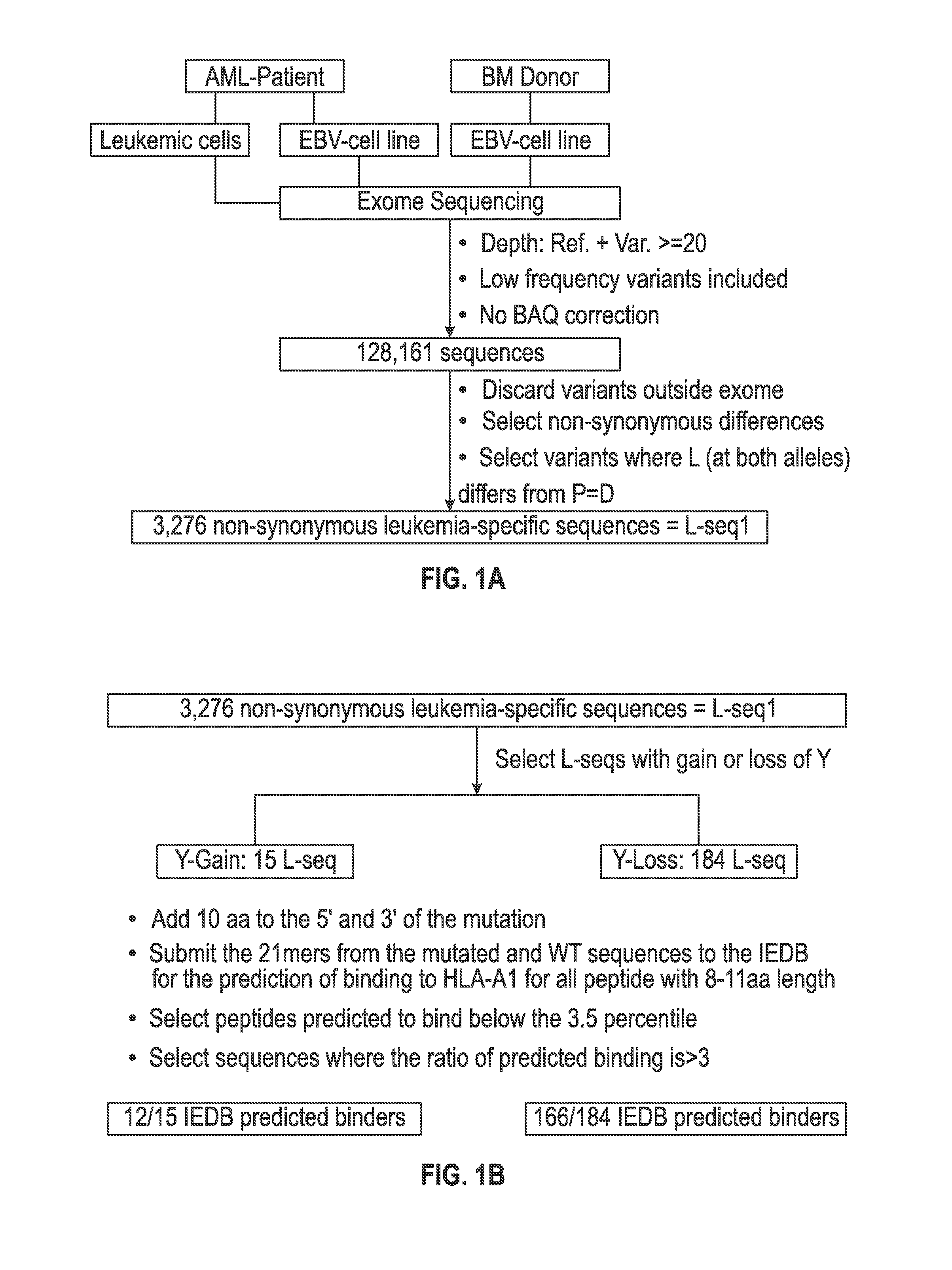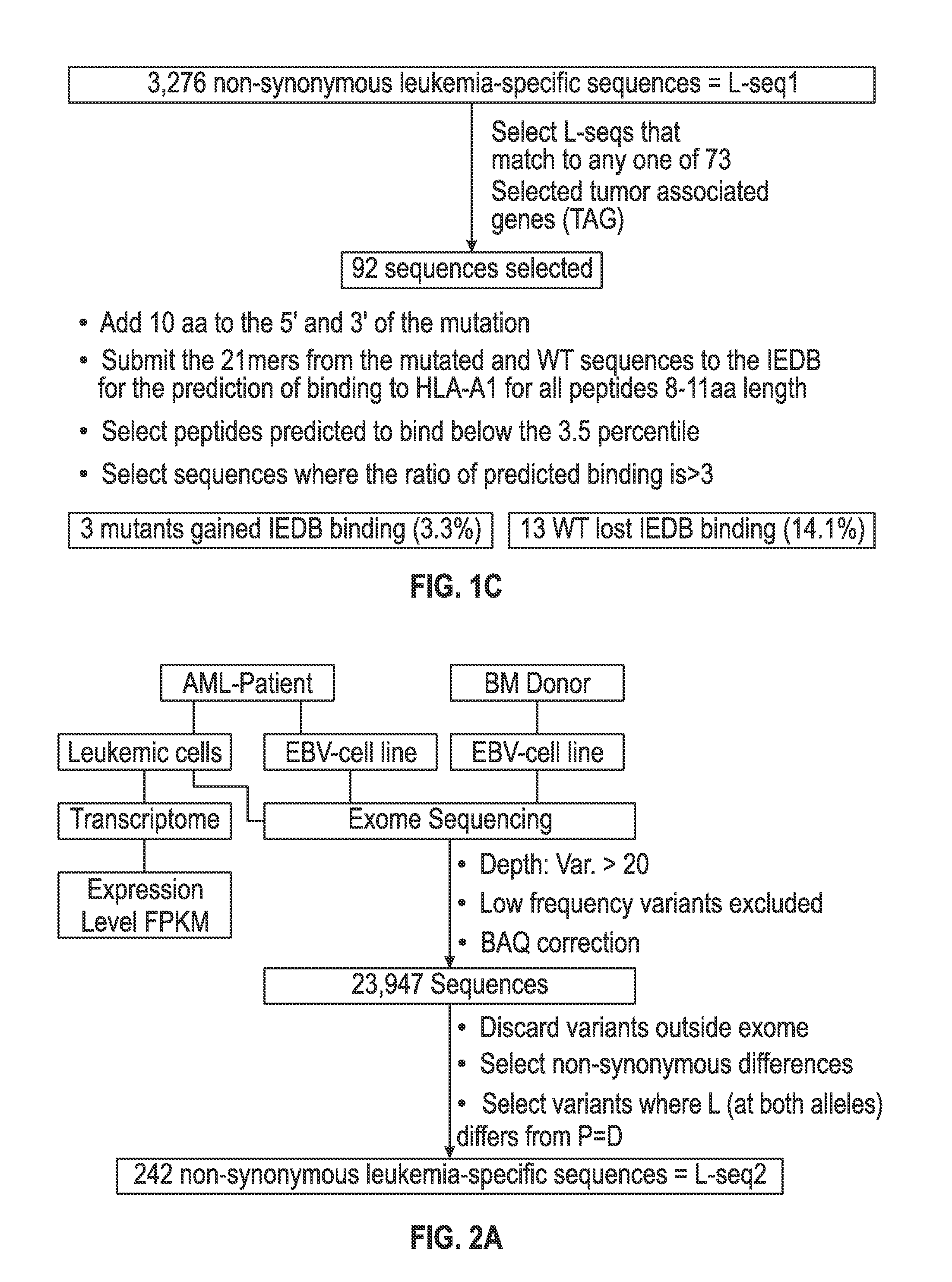Personalized cancer vaccines and adoptive immune cell therapies
a cancer vaccine and immune cell technology, applied in the field of personalized cancer vaccines and adoptive immune cell therapies, can solve the problems of non-specific cancer treatments (chemo and radiotherapy), elevated toxicity, and inapplicability
- Summary
- Abstract
- Description
- Claims
- Application Information
AI Technical Summary
Benefits of technology
Problems solved by technology
Method used
Image
Examples
example 1
Identifying Cancer Mutations from Exomic and Transcriptomic Libraries Using NGS
[0104]A scheme for identifying mutations in cancer cells that can be the target for immune recognition is shown in FIG. 1a-c. Leukemic cells (L) and Epstein Barr-transformed B cells (patient EBV-Cell line) (P) were obtained from patient #1 prior to hematopoietic stem cell transplantation (HSCT). Previously published methods were used to isolate from blood the leukemic cells (22, 27) and to prepare EBV cells (see, for example, Caputo J L, et al., J. Tissue Culture Methods 13: 39-44, 1991). An EBV-Cell line also was similarly produced from the bone marrow donor (D). The cells were frozen and maintained in liquid nitrogen.
[0105]DNA exome libraries were prepared from the patient #1 leukemic cells, the patient #1 EBV-cell line and from the donor EBV-cell line using NGS methods conducted under contract with Expression Analysis, Inc. (Durham, N.C.). An RNA transcriptome library was prepared by Expression Analysi...
example 2
Selecting Cancer Specific Mutations with Potential HLA Binding Motifs
[0118]The set of mutations from L-seq1 and Lseq2 were further selected to identify a smaller subset with prospects for binding to HLA antigens of the cancer patient. To this end, each L-seq was evaluated for mutants that involve either a gain or loss of a tyrosine. For L-seq1, there were 15 sequences with a tyrosine gain and 184 sequences with a tyrosine loss (FIG. 1b). From the 127 sequences from L-seq2 which were from genes expressed by the cancer cells, there were 5 sequences with a gain of tyrosine and 10 with a loss of tyrosine (FIG. 2b).
[0119]Peptide sequences containing the tyrosine involved mutant sequences (both gain and loss) and a corresponding wildtype peptide were transcribed (in silico) as 21 mer peptides with 10 amino acids located on each side of the tyrosine involved position. The 21 mer peptides were then evaluated for having an 8-11 aa epitope that would exhibit binding to HLA-A1 under the T cell...
example 3
Identifying Cancer Mutations—Patient #2
[0125]A modified scheme for identifying mutations in cancer cells that can be the target for immune recognition was used on samples obtained from patient #2 and is shown in FIG. 8a. Leukemic cells (L) and Epstein Barr-transformed B cells (patient PHA-Cell line) (P) were obtained from a patient prior to hematopoietic stem cell transplantation (HSCT). Previously published methods were used to isolate from blood the leukemic cells (22, 27) and to prepare EBV cells (see, for example, Caputo J L, et al., J. Tissue Culture Methods 13: 39-44, 1991). An EBV-Cell line also was similarly produced from the bone marrow donor (D). The cells were frozen and maintained in liquid nitrogen.
[0126]DNA exome libraries were prepared from the patient leukemic cells, the patient EBV-cell line and from the donor EBV-cell line using NGS methods conducted under contract with Expression Analysis, Inc. (Durham, N.C.). An RNA transcriptome library was prepared by Expressio...
PUM
| Property | Measurement | Unit |
|---|---|---|
| depth of coverage | aaaaa | aaaaa |
| size | aaaaa | aaaaa |
| strength | aaaaa | aaaaa |
Abstract
Description
Claims
Application Information
 Login to View More
Login to View More - R&D
- Intellectual Property
- Life Sciences
- Materials
- Tech Scout
- Unparalleled Data Quality
- Higher Quality Content
- 60% Fewer Hallucinations
Browse by: Latest US Patents, China's latest patents, Technical Efficacy Thesaurus, Application Domain, Technology Topic, Popular Technical Reports.
© 2025 PatSnap. All rights reserved.Legal|Privacy policy|Modern Slavery Act Transparency Statement|Sitemap|About US| Contact US: help@patsnap.com



